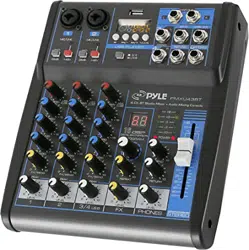Loading ...
Loading ...

www.PyleUSA.com www.PyleUSA.com
3 4
To EQ or Not to EQ
In general: less is better. There are many situations in which you'll need to cut certain
frequency ranges, but use boost sparingly, and with caution. Proper use of EQ can
eliminate interference between instruments in a mix and give the overall sound
better denition. Bad EQ-and most commonly bad boost-just sounds terrible.
Cut for a Cleaner Mix
For example: cymbals have a lot of energy in the mid and low frequency ranges that
you don't really perceive as musical sound, but which can interfere with the clarity of
other instruments in these ranges. You can basically turn the low EQ on cymbal
channels all the way down without changing the way they sound in the mix. You'll
hear the dierence, however, in the way the mix sounds more spacious," and instru-
ments in the lower ranges will have better denition. Surprisingly enough, piano also
has an incredibly powerful low end that can benet from a bit of low-frequency roll
-o to let other instruments-notably drums and bass-do their jobs more eectively.
Naturally you won't want to do this if the piano is playing solo.
The reverse applies to kick drums and bass guitars: you can often roll o the high end
to create more space in the mix without compromising the character of the instru-
ments. You'll have to use your ears, though, because each instrument is dierent and
sometimes you'll want the snap of a bass guitar, for example, to come through.
The fundamental and harmonic frequency ranges of some musical instruments
Boost with Caution
If you're trying to create special or unusual eects, go ahead and boost away as much
as you like. But if you're just trying to achieve a good-sounding mix, boost only in
very small increments. A tiny boost in the midrange can give vocals more presence,
or a touch of high boost can give certain instruments more "air." Listen, and if things
don't sound clear and clean try using cut to remove frequencies that are cluttering
up the mix rather than trying to boost the mix into clarity.
One of the biggest problems with too much boost is that it adds gain to the signal,
increasing noise and potentially overloading the subsequent circuitry.
Fundamental: The frequency that determines the basic musical pitch.
Harmonics: Multiples of the fundamentalfrequency that play a role
in determining the timbre of the instrument.
Some Frequency Facts
The lowest and highest frequencies than can be heard by the human ear are
generally considered to be around 20 Hz and 20,000 Hz. respectively. Average
conversation occurs in the range from about 300Hz to about 3,000 Hz.
The frequency of a standard pitchfork used to tune guitars and other instruments
is 440Hz (this corresponds to the "A3" key on a piano tuned to concert pitch).
Double this frequency to 880Hz and you have a pitch one octave higher
(i.e"A4" on the piano keyboard). In the same way you can halve the frequency
to 220Hz to produce "A2" an octave lower.
Loading ...
Loading ...
Loading ...
